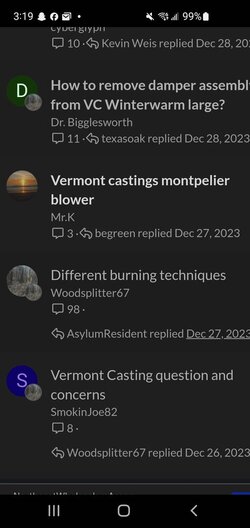arnermd
Minister of Fire
Welcome to the WTF club.... we have a lot of members. This happens to me regularly, every couple days or so.So I had one of those WTF moments last night.. I had cleaned to stove and swapped the steel cat to a ceramic cat.. ran if for a couple days.. last night did my normal reload for my overnight burn.. loaded the stove to the gills.. cat was something like 1000.. I immediately cut the air back all the way.. sat and watched football.. the whole time the cat was like 1430.. which is pretty normal.. all the suddenit started to climb.. and man was it drafting HARD.. cat went up to 1650.. the box turned into a flaming mess with an a$$ load of secondary combustion in the box.. it only stayed that way for 5/10 minutes and immediately dropped to the low 1500s.. but man was that a head scratcher.. I was looking at my stove and saying.. who the fOck are you..
Lately my cat temps have been cruising at 1600 with peaks up to 1670 or so, even with red oak and 20% air. I follow my same process that was working well a month ago and running at 1400 - 1500. Only thing I can think of that changed is increased draft due to lower outside temps. Maybe the wood is a bit drier as I am now pulling from the middle of my woodshed?
IDK.... cat alarm is now set to 1700 so I can get some sleep.


